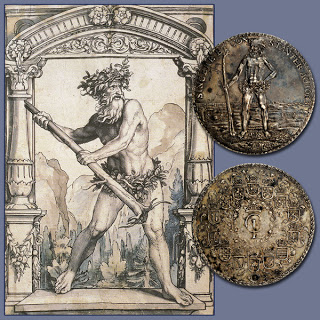
The concept of the Wildman dates back to mythological beings in the ancient cultures of Greece and Rome. Moritz Wormser’s November 1916 article in The Numismatist states that “he is a descendant of the Greek Satyr and the Roman Faun.” Throughout medieval Europe, the Wildman was used to instill fear in the local villagers to subscribe to certain religious beliefs. The Brunswick Duchies of north-central Germany are located in the silver rich region that includes the Harz Mountains. The myth that was created adapted the Wildman as a local guardian who protected the silver from would-be thieves. No matter which Wildman myth one hears, he is usually depicted the same: large and muscular, nude, or nearly so, and covered in thick body hair, often wearing a wreath of leaves around his loins and as a crown about his brow.
Starting in the late 1500s, under the reign of Julius and continuing on until the early 1800s, the Wildman is featured on various denominations in gold, silver, and copper. Throughout the centuries he has evolved from very hairy and somewhat hostile in appearance to slim and more effeminate in the later coinages. Most often, he is found standing next to, or brandishing a recently up-rooted tree. The Wildman became such an important part of the culture in the region that two Wildmen are sometimes found on the reverses of the coins of Brunswick-Wolfenbuttel, supporting the sides of the Coat of Arms (usually on the “mining talers”).
These large size, multiple talers generally were not intended to circulate; they were made as a savings fund. People were required by decree to purchase these large size coins in proportion to their wealth, in exchange for smaller denominations. If the Duke needed funds at a later date (for war or other reason), he could call up funds that were put away; the reason so many multiple talers exist is there was never a need to recall them.
Stack’s Bowers and Ponterio is excited to be able to offer this example to the collecting community. It has been a while since we have been able to offer such an example; the most recent example was in our (Stack’s) sale of the Michael Tallent Collection, April 2008, lot 220. Slightly finer in technical grade, that piece brought $9,775. This piece, called Extremely Fine, offers pleasing eye appeal with areas of dark toning. As expected for such a large coin, there are some minor contact marks; none detract from the overall appeal. Well struck with most details visible, though there is some weakness in places. Some doubling of details is seen from the multiple strikes needed to render all the details, as is usually the case on these large size coins.
Rarely are Wildman multiple talers offered at auction, and when they are, they are eagerly bid on. Our ANA sale is replete with great selections of European silver coins, anchored by Part III of the Demarete Collection (subject of a previous blog). If this is a specialty for you, be sure to view the offerings in our Official Stack’s Bowers and Ponterio sale for the American Numismatic Association’s World’s Fair of Money. The selections are particularly strong in German, Italian, Polish, and Russian, with wonderful rarities from around the globe providing a very well rounded offering of world coins. Keep an eye open either online at www.stacksbowers.com or in your mail box, as the sale will be posted and mailed out in early July. To see other highlights from the ANA sale as it is being prepared, check out our ANA sale “microsite” www.stacksbowersauctions.com and our blogs at www.stacksbowers.com.
For further information on this fascinating series, I highly recommend reading the above cited article, “Coins Showing the Wild Man” November 1916, The Numismatist, By Moritz Wormser.





